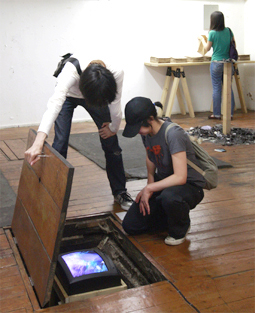 |
|
 |
Exhibition installation.
Photographs courtesy of CAMP and the artist |
|
|
I have never been to an S&M club. But after my visit to Satoshi Hashimoto's exhibition, presented by CAMP at Tokyo's Otto Mainzheim Gallery, I feel that I may have a small inkling of what kinds of diversions are on offer at such establishments.
Hashimoto's works take the form of participatory sculptures and installations. However, contrary to much art of the relational vein, which tends toward the creation of shared communal experiences, Hashimoto (b. 1977, Tokyo) explores what he calls fuka, a term pointing to a sense of suspense, risk and pressure, but also accentuated by a sense of weight. One could reference Hashimoto's interest to Claire Bishop's term "antagonistic aesthetics," coined as a critique of Nicolas Bourriaud's relational aesthetics, and foregrounding her argument that human relations are not only harmonious but also inherently conflictual and tense.
Upon entering the gallery, which has a somewhat dungeon-like quality (having been a small printing shop before becoming an alternative gallery space), I was invited to spend from eight to thirteen minutes inside an upright wooden box the size of a coffin. I agreed to this self-inflicted incarceration. The door swung shut and the gallery assistant padlocked the box. I could not move inside. A tiny monitor hung above my head, casting an uncomfortable electric glow within the coffin. I immediately felt a sense of panic, and initiated my meditation training learnt from my various stays in Zen monasteries during my post-graduate studies in mysticism. Sweat dripped down my face, which I wiped with my right arm, which could barely move. After ten minutes or so, the assistant opened the lock and air swept onto my face.
Another work, titled "gift", asked me to choose a brown paper bag with a torn page from a magazine inside it. I was asked to put the paper bag on my face as a mask, and burn the magazine page with a lighter. The instruction was to hold the burning page as long as I could, before letting it burn out on an altar-like metal plinth, surrounded by ashes. It was truly a delight to deal with fire in an art space in an age when safety issues seem to take all precedence over risk, and furthermore, to destroy an image which the artist had carefully chosen (albeit mass-printed).
Hashimoto's works act like anti-props, seemingly meaningless actions which only reveal themselves fully when one engages with them. The works demand of the viewer a commitment -- to time, to play, to incarceration and surrender. The actions offer a way out of an "art of the everyday" that seems dominant in Japan now, by moving into a decidedly Bataillian territory of content without meaning that refuses to accept the "everyday" as a neutral, un-problematic experience.
Outside the main gallery space was a micro-exhibition by Kanako Hayashi, an artist who makes works largely in public spaces. Titled "Street Practice", a video showed her "climbing" what looked like a concrete wall with round motifs on it. Turning one's head sideways it became apparent that she was "climbing" a road surface, using the skin of the city as a playground. A second work underneath the stairs consisted of old cigarette butts collected from the gallery and arranged into symbols from three major Japanese cigarette brands -- Hope, Peace, and Seven Stars. Hayashi's practice leans on what Michel de Certeau called "tactics": small, fluid actions which intelligently use the resources of the surroundings and transfer meaning into new formations. She uses her body as a meter or gauge with which to measure the complex situations she finds herself in and thus also to calm the city so that she can experience it. Walter Benjamin famously wrote that the modern city was a place of intensities where the individual was assaulted incessantly. Hayashi's street practice may be seen as a method of reclaiming this intensity and making the city a place of imagination and play.
(CAMP is a collective which organizes discussions and exhibitions on contemporary art.)
|